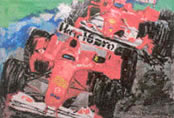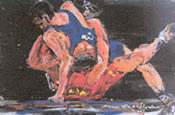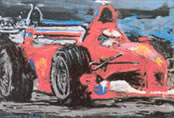Mina Papatheodorou-Valyraki – “Motion and Dynamism in Art” – 2002 Sport Artist of the Year
Artist Biography | Style & Inspiration | Key Sport Works & World Influence
“The difference between a small and large work is clearly of a physical nature, and not only the body, but the spirit too has to adjust to the limitation of a small frame. Personally I find this limitation unbearable. In large works I don’t have restricted boundaries. I always want to go outside the frame anyway. Almost all my works are cut off. The remainder of their ‘being,’ the imaginary, exists outside the frame.” ~ Mina Papatheodorou-Valyraki (Dialogue about Art, Livani Publishing, p.30-31)

F1 Double
Valyraki lists Jackson Pollack, Wassily Kandinsky, and Willem de Kooning, all masters of the ‘gestural avant-garde,’ as some of her favorite painters. They represent the Abstract Expressionist and Action styles of painting.
“Their works exude such an air of freedom. The flow, the intensity and the dynamic strength that satisfy and arouse you” (Dialogue about Art, p.31).
This attraction places her sensibilities in the center stream of contemporary scientific and cultural influences on art. Valyraki reflects the collective drive to answer questions about time and matter when she describes her urgency to push the limits of her painting technique. She chooses a style of painting that conveys the sense that the objects pictured extend into the space surrounding the canvas and continue moving in their direction of motion. This artistic treatment mirrors contemporary physics’ efforts to explain continuous matter and simultaneity of time.

Greoco Roman Wrestling
In response to late 19th and early 20th century discoveries about the mechanics of human visual perception as well as of photographic images being formed from tiny dots of light, Impressionist painters divided their canvases into tiny dots of color. The dots fused into clear images when the viewer stood at the appropriate distance. The organized dot patterns reflected the organized patterns that 19th century scientists believed composed images. In contrast, Jackson Pollack’s multi-layered drip and splatter paintings reflect the random particle movement postulated in contemporary physics’ Chaos Theory. Impressionism came from a mechanical interpretation of reality. Expressionism recommends a subjective, relative interpretation that factors in the eye of the beholder. Following the tendency of art theories to foreshadow scientific ones, 1940s Abstract Expressionist art theory was a harbinger of physic’s Chaos Theory and String Theory along with the principles of synchronicity, complementarity, and fused spacetime formulated many decades later.

Ferrari 2001
Valyraki’s contemporary audience responds sympathetically to her Abstract Expressionist treatment of light and motion not because all art lovers are trained physicists but because the contemporary zeitgeist, or cultural collective mind, resonates with the current shift from older mechanical theories of matter formation to contemporary energy-based theories. Physics professors are not the only people today who believe that objects are not solid but formed of constantly moving particles. Many popular television shows, cartoons, songs, and slang expressions take for granted the idea that reality is subjective, multi-dimensional, and changeable. These popular attitudes and artistic styles reflect a mainstream absorption of scientific debates about the fluid nature of matter, time, and perception.
All elements of Valyraki’s painting technique combine to produce a restless, ‘deforming’ style associated with Abstract Expressionism. The viewer has the sense that the painter wants to take apart the object portrayed as much as possible while still leaving it able to express and function at its most core energy and purpose. The furniture in a room is reduced to shimmering outlines. Ships are simplified into large swaths of color shaped by a few outlines that separate their hulls from vast oceans of signature Mediterranean blue paint. An Olympic ski champion’s skills seem to propel him off a snowy jump ramp by bold colors and strokes that touch and appear to extend beyond the canvas edge.
Similar to the brush stroke in Asian calligraphy, the energy conveyed by the gesture of the Abstract Expressionist’s paint brush is of primary importance, as it is the footprint of the subject’s life energy. In Valyraki’s works, swooping, definitive brush strokes evoke the sense of urgency of the viewer being propelled in a moving vehicle toward our fates at bittersweet, breakneck speed. Race cars are reduced to their most essential lines to imply their extraordinary speed and power. On winning his first race of the 2006 season, in an interview at Infineon Raceway, Nascar star, Jeff Gordon describes his peak driving experience in language that mirrors Valyraki’s statements about energy:
“For me, it’s not about the stats. One day, I’ll look … at those stats, but when you’re here right now, it’s about feeling that energy that comes. There’s no greater feeling in the world.”
With the priority of conveying life’s essential vital energy, Valyraki’s paintings retain an abstract base while usually including a defining representational element. A recognizable object or person is placed within a larger background field of light, color, and motion. The gesture of a directed swath of colored paint is used to convey emotional and dynamic information.
“I am interested in the nucleus of my theme and very often I have reached abstraction, while strongly seeking to do so. The representational says more to me though; it is closer to my pictorial vocabulary. I admire abstract artists such as Y. Klein, F. Stella, Rothko, but something always attracts me to the representational centre… As for Magritte, I meet him in the evening, before sunset, on the little island that floats in front of my house in Eretria” (Dialogue about Art, p.25).
Art critic, Carol Matthews Lascaris, President Emeritua of The National Museum of Women in the Arts in Washington, D.C. describes Valyraki’s style and its effects when she says: “Her paintings have an electricity, a dynamism that issues directly from her skilled use of a gemlike palette and a loaded brush… Vlayraki feels this rhythmic energy at her core and infuses her art with her own life force. This is the key to her expressive gifts as a painter”(Dialogue about Art, p. 13).
Valyraki’s mastery of her medium and her unique style and vision exert a significant influence on contemporary art. In the book, Dialogue about Art, Dora Eliopolou-Rogan, Ph. D., Commandeur des Arts et Lettres en France, describes Vlyraki’s resilience in the face of the fickle interpretations of history when she says,
“Her works project archetypes whose material expression is impervious to time.”
image sources
- Valyraki-features: Mina Valyraki

